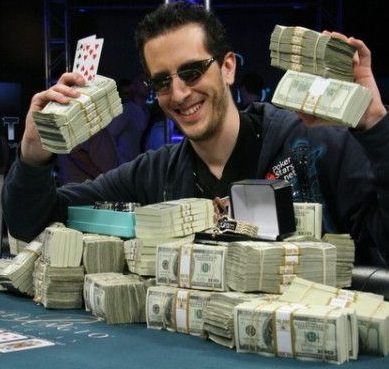|

Join our Newsletter
& get our free guide Starting Hands Revealed
We hate spam too!
We value your privacy and never share your email. All our emails have an opt-out link. Click it, and you will never hear from us again. |
How to understand your Sit'n Go Tournaments' opponents

You will encounter four types of opponents at small to mid stakes sit and go tournaments. If you want to make money at SNG, it is very important to correctly understand your opponents. If you know what mistakes bad players make, you can exploit their leaks and move to the next level. If you are playing small or mid stakes sit and go, you are up against a pretty well defined field. Every once in a while you will be up against a table which doesn't match up with what is described below, but such cases are few and far between. Types of sit'n go playersTypically, you will be up against one or two very good players, two or three additional ok players, two or three weak players, and two to five terrible players. What are these players like? Well, the very good players won't give you much of an edge. The best thing you can do is identify them and use the information (that they are good players) to your advantage when you play them in a hand. Good players play tight in the early stages of a SNG, so it is recommended to observe who plays few hands early as an estimate of the likelihood that the player's style is good. The "ok players" are the same as the very good players, but they will make a couple more mistakes. You should ignore them too, because they won't give you the poker edge you're looking for. You'll outplay them if you're a good poker player, but lets focus on the place where you can really make the money, the weak and terrible. Weak players and terrible players make the same mistakes at the small stakes sit and go level, it's just a question of how often they make these mistakes. The rest of the article will be a list of the mistakes these players make, and how you can understand the way they think. Draw your own conclusions for now as to how you should adjust: Mistake one: playing too many hands earlyThis is no secret, because poor poker players almost always play too many hands no matter what variety of poker you're playing. If you're not convinced, think about how many players you've seen lose buckets of money because they're playing too few hands. Not many, right? Poker is more fun if you're playing all the time and not just sitting there and watching. Remember that poor players are playing primarily for fun, not for profit. They may raise preflop with hands you wouldn't play. Remember this when you're putting them on a hand and when you're deciding whether to play a marginal hand in EP or MP.
Always keep in mind that if this kind of player doesn't know what is the smart move to make in a situation, he will always make the move that is the most fun. Mistake two: pot oddsBad players haven't generally read a lot of poker literature, so why should they understand the concept of pot odds? How did you learn this concept? Unless you're a poker genius, I doubt you came up with it on your own -- someone probably helped you discover it. Most bad players have not gone to any effort to learn how to play good poker, so they've probably never heard of pot odds. If they have heard of them, it's improbable that they have enough patience to actually try and use pot odds. This comes into play usually when your opponent is deciding whether to call. Remember from above that they want to call, because playing is fun. If you enjoy calling, you have a flush draw, and you don't know anything about pot odds, there's no reason not to call. When your opponent might have a draw, don't be subtle and fancy, punish this guy financially for making this kind of mistake. In an SNG, be careful about making this move on the flop because you're still 35% likely to be busted out of the hand if you can't beat the hand they're drawing towards, but be ultra-aggressive if the card doesn't hit on the turn. By the way as a side note as this is a long article, if you are looking for the online poker room with the most sit and goes, it is PokerStars. There have 24/7 action in all sorts of formats, and there are bad players there (and some good ones too).

Mistake three: SNGs, MTTs and ring games are differentSNGs are different from cash games because you don't want to go all in as often and put your life on the line. They are different from online MTTs because shorthanded play is so much more important. Therefore, most bad players are less comfortable playing shorthanded and are too likely to push in. Always remember that these players like to have fun, if they don't know the smart move to make in a situation, they will make the move that is the most fun. These players don't know how to play short-handed, so they will call if they think you're stealing blinds (even if they have poor cards). It's no fun to just push chips in all the time, so they are prone to a version of Fancy Play Syndrome - thinking they are making smooth moves when really they're just thinking of excuses to play lot of hands and act like the guys they see on TV. Mistake four: the concept of the "second best hand"This means that when you see a board like A♥K♥K♠, and a player makes an aggressive bet, he could well be holding something like A4, two hearts, or even QQ or JJ. The bad player with JJ isn't thinking "man, two overcards just hit", he's thinking "sweet, I have two pair kings and jacks, that's usually good enough to win!". The guy with the flush draw never thinks about the chance of someone hitting a full house. And if you're lucky enough to be up against Ax, this is his dream flop and you will never convince him that you have that king. What can you learn from this? Make sure never to bluff on scary looking boards (like AKK, QJT, three-suited flops), because even if your opponent has a relatively weak hand after the flop, he probably thinks he's pretty strong. Likewise, if you have trip kings and that ace is on the board, go ahead and make a big bet. If anyone has an ace, you will likely get all of his chips. SummaryThese are the big ones, and they all point to one successful strategy against the bad players you see at small stakes sit'n goes:
In order to make the most money at sit' go tournaments, play at an online poker room with a lot of action and a lot of players. For example the sit'n goes at pokerstars constantly attract a crowd of new players or casual players who do not know how to play SNG well. So go and play sit and go tournaments at pokerstars and see for yourself how much money you can make.

|









